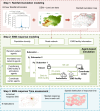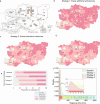Supply-demand mismatch causes substantial deterioration in prehospital emergency medical service under disasters
- PMID: 40775464
- PMCID: PMC12331904
- DOI: 10.1038/s44172-025-00481-8
Supply-demand mismatch causes substantial deterioration in prehospital emergency medical service under disasters
Abstract
Floods severely disrupt prehospital emergency medical services (EMS), which dispatch medical personnel to deliver on-scene treatment, by hindering ambulance mobility and increasing medical demand. Here, we proposes a simulation-based framework that integrates flood inundation, EMS facility data, and population-weighted medical demand to assess regional EMS performance under different flood scenarios. Applied to Zhengzhou, China, the framework evaluates system responses during normal conditions, 1-in-50-year, 1-in-100-year floods, and the extreme "7.20" rainfall disaster. Results show dramatic increases in response times during "7.20", with resource shortages identified as a key delay factor. Three mitigation strategies are evaluated: adding ambulances, inter-subcenter ambulance sharing, and a hybrid approach. The results demonstrate that ambulance sharing outperforms limited ambulance additions, increasing 10-min and 30-min population coverage by 15.2% and 22.7%, respectively, while the hybrid approach achieves optimal improvement. The findings offer policy guidance for improving EMS resilience in flood-prone regions and support global urban disaster preparedness.
© 2025. The Author(s).
Conflict of interest statement
Competing interests: The authors declare no competing interests.
Figures








Similar articles
-
Emergency Medical Services Streaming Enabled Evaluation In Trauma: The SEE-IT Feasibility RCT.Health Soc Care Deliv Res. 2025 May;13(26):1-38. doi: 10.3310/EUFS2314. Health Soc Care Deliv Res. 2025. PMID: 40445854 Clinical Trial.
-
Community First Responders' role in the current and future rural health and care workforce: a mixed-methods study.Health Soc Care Deliv Res. 2024 Jul;12(18):1-101. doi: 10.3310/JYRT8674. Health Soc Care Deliv Res. 2024. PMID: 39054745
-
The dynamics and underlying factors shaping rural-urban connections for rural flood hazard susceptibility in Pakistan: the case of Khyber Pakhtunkhwa.J Environ Manage. 2025 Aug;389:125831. doi: 10.1016/j.jenvman.2025.125831. Epub 2025 Jun 3. J Environ Manage. 2025. PMID: 40466309
-
Business and continuity of operations: care of the critically ill and injured during pandemics and disasters: CHEST consensus statement.Chest. 2014 Oct;146(4 Suppl):e103S-17S. doi: 10.1378/chest.14-0739. Chest. 2014. PMID: 25144857 Free PMC article.
-
Does the use of dedicated dispatch criteria by Emergency Medical Services optimise appropriate allocation of advanced care resources in cases of high severity trauma? A systematic review.Injury. 2015 Jul;46(7):1197-206. doi: 10.1016/j.injury.2015.03.033. Epub 2015 Apr 2. Injury. 2015. PMID: 25863418
References
-
- Kim, K. & Oh, B. Prehospital triage in emergency medical services system: a scoping review. Int. Emerg. Nurs.69, 101293 (2023). - PubMed
-
- Majlesinasab, N., Maleki, M. & Nikbakhsh, E. Performance evaluation of an EMS system using queuing theory and location analysis: a case study. Am. J. Emerg. Med.51, 32–45 (2022). - PubMed
-
- Liu, K. Z., Zhai, C. H., Dong, Y. & Meng, X. H. Post-earthquake functionality assessment of urban road network considering emergency response. J. Earthq. Eng.27, 2406–2431 (2023).
-
- Darestani, Y. M., Webb, B., Padgett, J. E., Pennison, G. & Fereshtehnejad, E. Fragility analysis of coastal roadways and performance assessment of coastal transportation systems subjected to storm hazards. J. Perform. Constr. Facil.35, 04021088 (2021).
-
- Alabbad, Y., Mount, J., Campbell, A. M. & Demir, I. Assessment of transportation system disruption and accessibility to critical amenities during flooding: Iowa case study. Sci. Total Environ.793, 148476 (2021). - PubMed
Grants and funding
LinkOut - more resources
Full Text Sources
